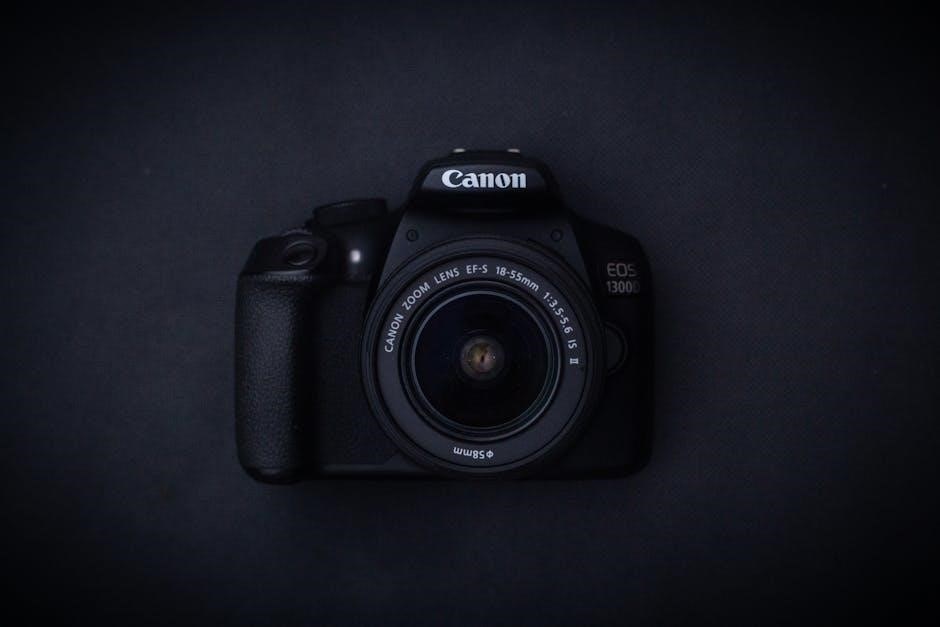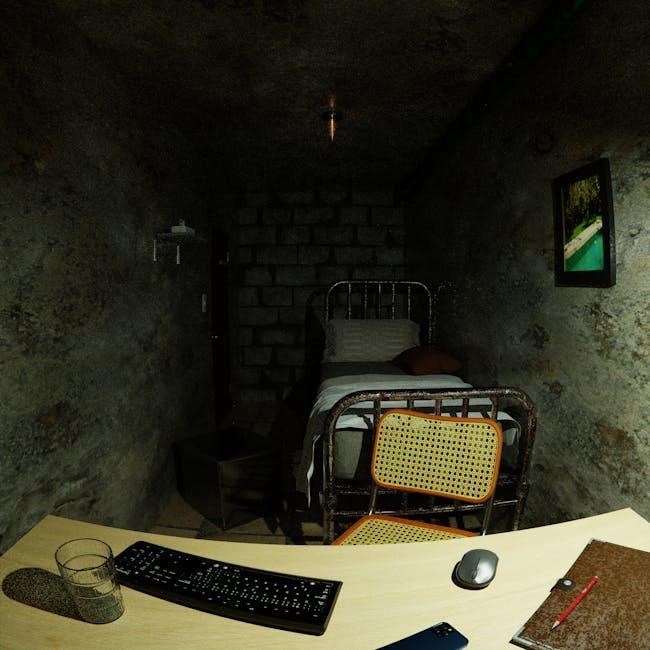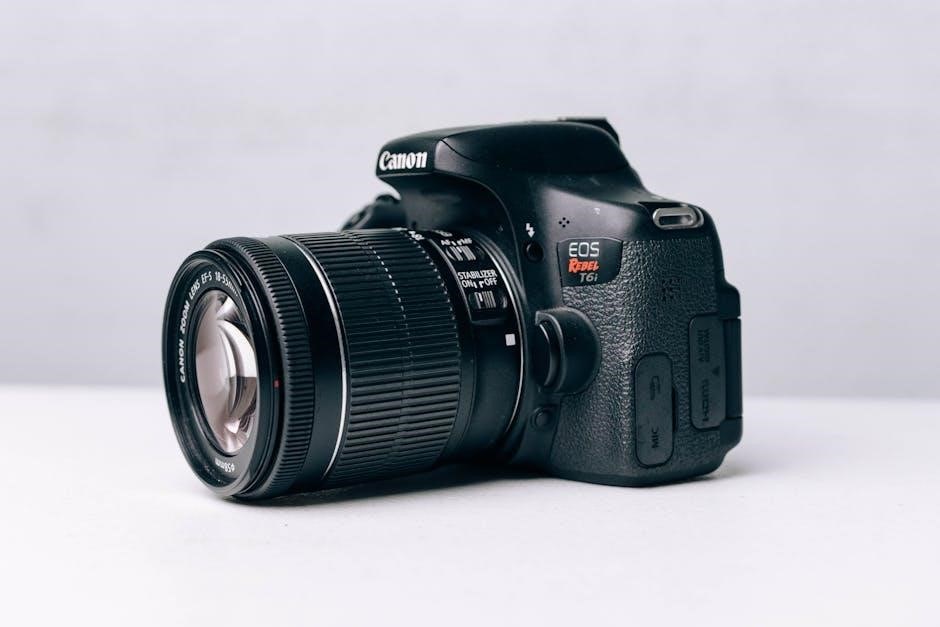
The Canon Digital Rebel XT, known as the EOS 350D, is an 8-megapixel DSLR designed for photography enthusiasts. This manual guides users through its features, ensuring optimal performance and creativity.
1.1 Overview of the Canon Digital Rebel XT
The Canon Digital Rebel XT, also known as the EOS 350D, is an 8-megapixel digital single-lens reflex (DSLR) camera designed for photography enthusiasts. It features a high-resolution CMOS sensor, compatibility with Canon EF lenses, and a variety of shooting modes. The camera offers a compact and lightweight design, making it portable for everyday use. With its intuitive controls and advanced features, the Rebel XT is ideal for capturing high-quality images in diverse settings. The manual provides a comprehensive guide to unlocking its full potential, ensuring users can navigate its capabilities effortlessly.
1.2 Importance of the Manual
The manual is essential for understanding and maximizing the potential of the Canon Digital Rebel XT. It provides detailed guidance on camera operations, features, and settings, ensuring users can navigate its capabilities confidently. Whether you’re a beginner or an advanced photographer, the manual offers insights into customizing settings, troubleshooting common issues, and maintaining the camera. It covers topics like shooting modes, sensor care, and firmware updates, making it an indispensable resource. By following the manual, users can optimize image quality, explore creative possibilities, and extend the camera’s lifespan. This comprehensive guide ensures that photographers of all levels can unlock the full functionality of the Canon Digital Rebel XT and achieve their creative goals effectively.

Key Features of the Canon Digital Rebel XT
The Canon Digital Rebel XT features an 8-megapixel CMOS sensor, compatibility with EF lenses, and various shooting modes for versatile photography. It offers quick performance and high-quality images.
2.1 Design and Build Quality
The Canon Digital Rebel XT features a compact and lightweight design, making it easy to carry and handle. Its durable construction includes a polycarbonate body with a metal chassis, ensuring robustness while keeping the camera portable. The ergonomic grip provides a comfortable hold, allowing for extended shooting sessions. The 1.8-inch LCD screen offers a clear view of images and settings, while the optical viewfinder delivers an accurate preview of the scene. The camera’s intuitive controls are logically arranged, with buttons and dials placed for easy access. Built with durability in mind, the Rebel XT is designed to withstand regular use, making it a reliable choice for photographers of all levels. Its compact size and sturdy build make it ideal for both casual and professional photography.
2.2 Sensor and Image Quality
The Canon Digital Rebel XT is equipped with an 8.0-megapixel CMOS sensor, delivering high-resolution images with a maximum size of 3456 x 2304 pixels. The sensor’s high sensitivity and advanced noise reduction capabilities ensure clear and detailed photos, even in low-light conditions. The camera supports various image formats, including JPEG and RAW, allowing for flexibility in post-processing. With a wide dynamic range, the Rebel XT captures rich colors and subtle tonal variations, making it suitable for both casual and professional photography. The sensor’s compatibility with Canon EF lenses, including EF-S lenses, further enhances its versatility, enabling users to achieve high-quality results across diverse shooting scenarios. This combination of sensor technology and image processing ensures the Rebel XT produces outstanding image quality for its class.

Using the Camera
Mastering the Canon Digital Rebel XT involves understanding its basic operations. Turn it on, navigate settings, and explore shooting modes to capture stunning photos effortlessly for any photography level.

3.1 Basic Camera Controls
Familiarizing yourself with the Canon Digital Rebel XT’s basic controls is essential for effective photography. The Mode Dial allows selection of shooting modes, from automatic to manual. The Shutter Button, located on the grip, controls exposure and focuses when pressed halfway. The Aperture/Exposure Compensation Button adjusts settings for precise control. The Multi-Controller navigates menus and selects AF points. The Viewfinder provides a clear preview of your shot, while the LCD Panel displays settings and image reviews. Understanding these controls ensures smooth operation and helps you capture images confidently. Mastering them is the first step in unlocking the camera’s full potential for stunning photography.
3.2 Navigating the Menu System
The Canon Digital Rebel XT’s menu system is designed to be intuitive and user-friendly; Access the menu by pressing the Menu button on the camera’s back. Use the Multi-Controller to navigate through options, and the SELECT button to make selections. The menu is divided into tabs: Shooting, Playback, and Setup. The Shooting tab allows adjustments like image quality and white balance. The Playback tab offers options for reviewing and managing images. The Setup tab covers camera settings, such as date/time and firmware updates. Custom functions and personal settings can also be accessed here, enabling users to tailor the camera to their preferences. Mastering the menu system enhances your ability to optimize camera performance for various shooting scenarios.

Shooting Modes
The Canon Digital Rebel XT offers a range of shooting modes, including Full Auto, Portrait, Landscape, Close-up, Night Portrait, Manual, and Program AE, catering to both beginners and advanced photographers.
4.1 Basic Zone Modes
The Canon Digital Rebel XT offers a variety of Basic Zone Modes designed to simplify photography for users of all skill levels. These modes include Full Auto, Portrait, Landscape, Close-up, Night Portrait, and Flash Off. Each mode automatically adjusts camera settings to optimize results for specific shooting scenarios. For instance, Portrait mode softens backgrounds to emphasize subjects, while Landscape mode ensures sharp focus across the entire image. Close-up mode is ideal for capturing fine details, and Night Portrait mode balances flash with ambient light for natural results. These modes make it easy for beginners to achieve professional-looking photos without manual adjustments.
4.2 Creative Zone Modes
The Canon Digital Rebel XT’s Creative Zone Modes offer advanced control for experienced photographers. These modes include Program AE (P), Shutter Priority AE (Tv), Aperture Priority AE (Av), Manual (M), and Auto Depth-of-Field AE (A-Dep). In Program AE, the camera selects aperture and shutter speed, but users can adjust these settings for more creativity. Shutter Priority AE allows manual shutter speed adjustment to freeze or blur motion, while Aperture Priority AE enables control over aperture for depth-of-field effects. Manual mode provides full control over both aperture and shutter speed. Auto Depth-of-Field AE automatically adjusts aperture and shutter speed to ensure sharp focus across a scene. These modes empower photographers to refine their techniques and achieve precise results tailored to their artistic vision.

Customization Options
The Canon Digital Rebel XT offers extensive customization options, allowing users to tailor camera settings to their preferences. Custom functions enable adjustments to autofocus, metering, and more.
5.1 Custom Functions
The Canon Digital Rebel XT provides a range of Custom Functions, allowing photographers to fine-tune camera behavior to suit their shooting style. These functions include settings for autofocus, exposure, and metering modes. Users can adjust options such as the AF activation button, metering mode, and ISO expansion. Additionally, custom functions enable control over flash synchronization speed and the use of the AE lock button. These settings can be accessed via the camera’s menu system, offering flexibility for both casual and advanced photographers. By customizing these functions, users can optimize the camera’s performance for specific scenarios, enhancing their overall photography experience.
5.2 Personalizing Settings
The Canon Digital Rebel XT provides a comprehensive suite of personalization options, allowing photographers to tailor the camera to their specific needs and shooting styles for enhanced creativity and efficiency. Users can save their custom settings to a memory card, making it easy to transfer configurations between cameras and maintain consistency across different devices, which is particularly useful for those who work with multiple cameras. The camera also allows customization of the AE lock button, providing quick access to frequently used functions and enhancing operational efficiency during shoots, which can be crucial for capturing fleeting moments. Furthermore, photographers can set preferences for autofocus behavior, JPG processing parameters, and other features to align with their creative vision and achieve the desired results. These personalization options not only streamline workflows but also allow the camera to adapt to diverse shooting scenarios, accommodating both casual and advanced photographers. By customizing these settings, users can optimize the camera’s performance, ensuring a more personalized and efficient photography experience that meets their

Advanced Features
The Canon Digital Rebel XT offers advanced features like an 8-megapixel CMOS sensor, RAW image capture, and E-TTL II flash metering for enhanced control and image quality.
6;1 White Balance and Autofocus
White Balance on the Canon Digital Rebel XT allows users to adjust color tones to match lighting conditions, ensuring accurate hues. Options include Auto, Daylight, Shade, Tungsten, Fluorescent, and Custom, which can be set manually. Autofocus is powered by a 7-point AF system, offering quick and precise subject tracking. The camera features One-Shot AF for stationary subjects and AI Servo AF for moving subjects. AF points can be selected manually or automatically, with an AF-assist beam aiding focus in low-light conditions. These features enhance image sharpness and color accuracy, making the XT versatile for various photography needs.
6.2 Exposure Compensation
Exposure Compensation on the Canon Digital Rebel XT allows users to adjust image brightness by +/-2 stops in 1/3-stop increments. This feature is accessible via the Quick Control Dial, making it easy to fine-tune exposures without navigating through menus. The LCD panel displays the compensation amount, ensuring users can monitor adjustments effectively. Exposure Compensation is particularly useful for correcting scenes with backlighting or high contrast, helping to preserve details in both highlights and shadows. By enabling precise control over exposure, this feature enhances image quality and provides flexibility in various lighting conditions, making it an essential tool for achieving creative photography goals. Proper use of Exposure Compensation ensures well-balanced images, even in challenging environments, allowing photographers to capture their vision accurately.

Maintenance and Care
Regularly clean the sensor and lens to prevent dust and smudges. Store the camera in a dry, cool place to avoid moisture damage. Check for firmware updates to ensure optimal performance and address any issues promptly.
7.1 Cleaning the Sensor and Lens
Regular cleaning of the sensor and lens is essential for maintaining image quality. Use a soft-bristle brush or bulb blower to remove dust from the sensor. For stubborn spots, dampen a microfiber cloth with distilled water and gently wipe the lens surface. Avoid using harsh chemicals or tissues, as they may damage the coatings. Clean the lens in a circular motion, starting from the center and moving outward. For the sensor, use a dry microfiber cloth or a specialized sensor cleaning swab. Always handle the camera with care, and clean in a dust-free environment. Refer to the manual for detailed cleaning instructions. Regular maintenance ensures sharp, clear images and prolongs the camera’s lifespan. Clean the sensor and lens periodically to prevent dust buildup and maintain optimal performance.
7.2 Updating Firmware
Updating the firmware on your Canon Digital Rebel XT is crucial for enhancing performance and fixing issues. Start by visiting the Canon support website to check for the latest firmware version for the EOS 350D. Download the update and the EOS Utility software if you don’t already have it. Connect your camera to your computer using the provided USB cable. Launch the EOS Utility and follow the prompts to check for and install the firmware update. Ensure the camera’s battery is fully charged to prevent any interruptions during the process. Carefully follow all on-screen instructions to complete the update successfully. Regular firmware updates ensure your camera operates at its best, with improved functionality and any necessary bug fixes. Always refer to the manual or Canon’s support resources for detailed guidance on updating your camera’s firmware.

Troubleshooting Common Issues
Identify error codes and resolve issues like sensor cleaning, battery problems, or firmware glitches. Resetting the camera or using EOS Utility can often fix common malfunctions effectively.
8.1 Identifying Error Codes
The Canon Digital Rebel XT displays error codes to indicate specific issues. Common errors include E0001 to E0018, which relate to the camera’s internal state. For instance, Err 01 may indicate a CompactFlash (CF) card error, while Err 02 could signal a communication problem between the lens and the camera body. Understanding these codes is crucial for diagnosing and resolving problems. Users can refer to the manual or Canon’s official support resources to decode these errors. Basic troubleshooting steps, such as turning the camera off and on or replacing the CF card, often resolve these issues. Persistent errors may require more advanced solutions, such as updating firmware or consulting professional support. Always ensure the camera is properly maintained to minimize error occurrences and maintain optimal performance.
8.2 Resetting the Camera
Resetting the Canon Digital Rebel XT can resolve persistent issues by restoring factory settings. To reset, navigate to the Menu and select Setup. Scroll to the Clear Settings option and choose OK. This will reset all customizations, including shooting modes and personalized preferences. Note that resetting does not affect stored images or firmware updates. Regularly resetting can help maintain camera performance and resolve software glitches. Always ensure the camera is powered off before performing a reset to avoid data loss. For a full factory reset, refer to the manual or Canon’s official support for detailed instructions. Resetting is a useful troubleshooting step before seeking professional assistance.

Accessories and Resources
The Canon Digital Rebel XT supports various accessories like EF lenses, tripods, and external flashes. Additional resources include the EOS Utility software and Canon’s official support website for troubleshooting and updates.
9.1 Recommended Accessories
To enhance your Canon Digital Rebel XT experience, consider essential accessories. The EF and EF-S lenses offer versatility for various photography needs. A tripod ensures stability for low-light shots, while an external flash improves lighting control. High-capacity memory cards, like CompactFlash, expand storage for more images. The EOS Utility software facilitates remote shooting and image transfer. A lens cleaning kit helps maintain your gear, and a camera bag protects your equipment. These accessories optimize performance and creativity, ensuring you get the most out of your camera. For compatibility and updates, visit Canon’s official support website.
9.2 Additional Resources and Support
Canon provides comprehensive resources to support your Digital Rebel XT. The official Canon website offers firmware updates, software downloads, and troubleshooting guides. The EOS Utility software enables remote camera control and image transfer. Additionally, Canon’s customer service and community forums are available for assistance. Online tutorials and workshops can help you master advanced techniques. For repairs, authorized service centers ensure genuine parts and expert care. Stay updated with the latest accessories and software to maintain peak performance. These resources ensure you can resolve issues and continue capturing high-quality images with your Canon Digital Rebel XT.